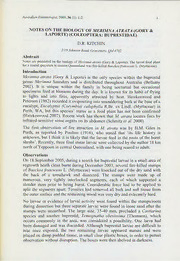
Notes on the biology of Merimna atrata (Gory and Laporte) (Coleoptera: Buprestidae) PDF
Preview Notes on the biology of Merimna atrata (Gory and Laporte) (Coleoptera: Buprestidae)
Australian Entomologist, 2009, 36 (1): 1-2 1 NOTES ON THE BIOLOGY OF MERIMNA ATRATA (GORY & LAPORTE) (COLEOPTERA: BUPRESTIDAE) D.R. KITCHIN 2/19 Johnson Road, Gracemere, Qld 4702 Abstract Notes are presented on the biology of Merimna atrata (Gory & Laporte). The larval food plant for a reared specimen in eastern Queensland was fire-killed Baeckea frutescens L. (Myrtaceae). Introduction Merimna atrata (Gory & Laporte) is the only species within the buprestid genus Merimna Saunders and is distributed throughout Australia (Bellamy 2002). It is unique within the family in being nocturnal but occasional specimens feed at blossom during the day. It is known for its habit of flying to lights and into fires, apparently attracted by heat. Hawkeswood and Peterson (1982) recorded it ovipositing into smouldering bark at the base of a eucalypt, Eucalyptus (Corymbia) calophylla R.Br. ex Lindl. (Myrtaceae) in Perth, WA, but this species9 status as a food plant has not been confirmed (Hawkeswood 2007). Recent work has shown that M. atrata locates fires by infrared-sensitive sense organs on its abdomen (Schmitz et al. 2000). The first observation of fire attraction in M. atrata was by H.M. Giles in Perth, as reported by Poulton (1916), who stated that 8its life history is unknown, but I think it is likely that the larvae feed in the roots of the burnt shrubs9. Recently, three final instar larvae were collected by the author 18 km north of Yeppoon in central Queensland, with one being reared to adult. Observations On 18 September 2005, during a search for buprestid larvae in a small area of regrowth heath clean burnt during December 2003, several fire-killed stumps of Baeckea frutescens L. (Myrtaceae) were knocked out of the dry sand with the back of a tomahawk and dissected. The stumps were made up of numerous, very tightly interlocked segments, each of which supported a slender stem prior to being burnt. Considerable force had to be applied to split the segments apart. Termites had removed all bark and soft tissue from the outer surface and the remaining wood was very dry and extremely hard. No larvae or evidence of larval activity were found within the stumps/roots during dissection but three separate larvae were found in loose sand after the stumps were unearthed. The large size, 35-40 mm, precluded a Castiarina species and another buprestid, Temognatha obesissima (Thomson), which occurs commonly in the area, was considered a possibility. One larva had been damaged and was discarded. Although buprestid larvae are difficult to rear once exposed, the two remaining larvae appeared mature and were placed on damp padded tissue, in small clear plastic boxes, in order to permit observation without disruption. The boxes were then shelved in darkness. 2 Australian Entomologist, 2009, 36 (1) On 25 October 2005, a parasitic larva approximately 12 mm long was seen attached to the side of one of the buprestid larvae. The parasite was detached in an attempt to save the buprestid larva and boxed separately. Both larvae remained alive for some time but failed to pupate. The remaining larva pupated on 29 October 2005 and an adult Merimna atrata emerged during the night of 13 November 2005. It had become apparent that it was not T. obesissima as expected when the white pupa darkened to black prior to emergence. Like the pupa, the adult lay on its dorsal surface and moved its legs for several days before turning right way up. It is retained in the author9s collection. Discussion Buprestidae are considered to breed within the stems, roots or leaves of living or dead plants. Many small species are leaf miners. The larvae recorded here were unearthed in loose sand, with none found by dissecting the stumps, but it is not known whether they were free-living or were simply dislodged during the collection process. In December 2004, twelve months after the fire and following a heavy storm on the previous afternoon, M. atrata adults were common on the stems of low, green regrowth within the burnt area. If oviposition in this species only occurs in direct response to fire, as recorded by Hawkeswood and Peterson (1982), the adults observed might have been newly emerged after a life cycle of only one year with some, e.g. the three larvae collected, taking two or more years to complete development. The wide distribution of M. atrata suggests that it uses a range of fire-killed timber other than Baeckea frutescens, which has a restricted habitat. Acknowledgement I thank Dr Rhonda Melzer (Environmental Protection Agency [EPA], Rockhampton) for assistance with plant identification. References BELLAMY, C.L. 2002. Coleoptera: Buprestoidea. In: Houston, W.W.K. (ed.), Zoological catalogue of Australia. Volume 29.5. CSIRO Publishing, Melbourne; xii + 492 pp, 4 pls. HAWKESWOOD, T.J. 2007. Review of the biology of the genus Merimna Saunders, 1868 (Coleoptera: Buprestidae). Calodema 9: 12-13. HAWKESWOOD, T.J. and PETERSON, M. 1982. A review of larval hosts records for Australian jewel beetles (Coleoptera: Buprestidae). Victorian Naturalist 99: 240-251. POULTON, E.B. 1916. The habits of the Australian buprestid <fire beetle=, Merimna atrata Lap. et Gory. Proceedings of the Entomological Society of London 1915(1): iii-iv. SCHMITZ, H., SCHMITZ, A. and BLECKMAN, H. 2000. A new type of infrared organ in the Australian <fire-beetle=, Merimna atrata (Coleoptera: Buprestidae). Naturwissenschaften 12: 542-545.
